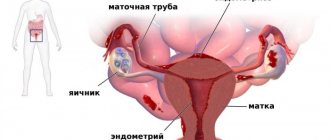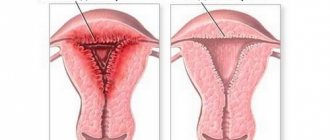Last update: 10/01/2019
Every second woman puts her body at risk when deciding to terminate an unwanted pregnancy. Modern medicine offers a gentle method of getting rid of the fertilized egg using hormonal drugs. However, it does not guarantee a 100% result and requires strict medical supervision of the procedure. Representatives of the fair sex are especially concerned about the question of when menstruation comes after medical termination of pregnancy.
- Pharmacological abortion: what is it?
- Pros and cons of medical abortion
- Restoration of the menstrual cycle
- What to do if menstruation does not occur
- Contraindications to pharmacological abortion
Pharmacological abortion: what is it?
Medical abortion is a forced termination of pregnancy using pharmaceutical means. Its use is indicated on the 42-49th day of delayed menstruation, which is equal to 6-7 weeks. The likelihood of successful completion of the procedure directly depends on the time of absence of menstruation: the shorter the delay, the higher the guarantee of termination of pregnancy. However, in some countries, pharmacological abortion is allowed up to 24 weeks.
Medical termination of pregnancy is carried out using medications whose main active ingredient is the hormone mifepristone, for example, Mifegin, Pencrafton, Mifeprex, Mifolian. The effect of hormonal drugs is to block progesterone, which leads to the rejection of the fetal egg and its release from the uterus, accompanied by bleeding. In turn, misoprostol replaces prostaglandin, which stimulates contraction of the uterine organ, which helps remove the remains of the fertilized egg from the uterus. Medicines are taken under the strict supervision of a doctor and according to a schedule, taking into account the individual capabilities of the woman.
After an abortion induced by medication, it is mandatory to undergo an ultrasound of the pelvic organs to check for the presence of remnants of the fertilized egg. If the uterine organ is clean, then the risk of complications is minimal. According to medical indications, for preventive purposes after a pharmacological abortion, additional therapy with antibacterial agents and for hormone levels is prescribed.
https://youtu.be/zZRYHY40YIY
Duration of menstruation
How long your period will last after an abortion also depends on many factors, and primarily on the woman’s body’s ability to recover from stressful situations.
Do not confuse spotting after abortion procedures with menstruation. A normal menstrual cycle ranges from 21 to 35 days. Bleeding that occurs after an abortion is not a critical day, and can continue for 3-10 days with varying intensity, depending on the chosen method of termination of pregnancy. Most often, the first menstruation comes a little later than with a normal cycle, approximately up to 5 weeks. However, there are situations when the delay can last up to 8 weeks. Often, after termination of pregnancy, menstruation is very scanty and lasts from 3 to 10 days.
Pros and cons of medical abortion
Any medical procedure has different consequences. For example, after a drug abortion, bleeding begins or, conversely, your period may not come. Therefore, it is necessary to know all the advantages and disadvantages of this procedure.
The main advantages of medical abortion include:
- High effectiveness of the technique. In 92-99% of cases the procedure is successful.
- Minimum or no preparatory activities.
- Painless and quick: the manipulation is reduced to the usual oral administration of tablets.
- No anesthesia or narcotic sleep is required.
- Exclusion of surgical curettage, which preserves the integrity of the cervix and endometrium of the uterus.
- No psychological trauma.
- Does not affect the reproductive functions and fertility of a woman.
However, there are also some disadvantages of pharmacological abortion that you should pay attention to before taking the medicine:
- Insufficient effect of the drug leads to the abandonment of the fertilized egg or part of it, the removal of which requires surgical intervention.
- High risk of uterine bleeding, fraught with heavy blood loss. In rare cases, surgery or blood transfusion is required.
- Severe pain in the lower peritoneum, which appears on the second day after taking the pills and is often accompanied by a feeling of discomfort and nausea.
- Body hyperemia and high temperature.
- Headaches and dizziness.
- Sudden jumps in blood pressure.
- Allergic reactions or individual intolerance to the drug.
- The hormonal nature of the pills leads to changes in the balance of hormones and threatens with unpredictable results.
- Infectious lesions of the female genital organs.
- Accumulation of blood clots in the uterine cavity, or hematometra, provoked by spasm of the uterine cervix.
- Difficulty in determining the arrival of menstruation.
In addition, it is not recommended to take medications that cause fetal rejection if the pregnancy is over 6 weeks. If the timing is inaccurate, the traditional method of abortion is used.
https://youtu.be/nTXl_RNm-xM
Restoring a cycle after vacuum cleaning
Vacuum cleaning is more gentle, although it is more difficult than the medicinal method. In this case, the fertilized egg is removed from the woman’s body using vacuum suction, which acts on the uterus mechanically.
Complications of this method include excessive blood loss if cleaning results in injury.
Restoring the cycle here is especially difficult. Women who have given birth recover quite quickly, but in other cases the numbers can be completely different.
As a rule, the cycle is restored a month after the interruption. In some cases, the recovery process can take up to 2 months, but sometimes it can even take up to 6 months.
Intimacy after an abortion: when can you have sex after an abortion?
Symptoms of the onset of menopause in women and men, how to treat its manifestations with medications and folk remedies in the next article.
Which pads are better: https://venerolog-ginekolog.ru/gynecology/menstruation/prokladki-pri-mesyachnyih.html.
Restoration of the menstrual cycle
All patients, without exception, are concerned about the question of when menstruation will begin after a medical abortion and how many days will it take for it to become established. After pharmacological termination of pregnancy, the menstrual cycle forms again. Its first day (1-2 days after taking the medicine) coincides with the onset of bleeding, signaling the detachment of the fertilized egg and the release of the egg. When menstruation begins, there is scanty bleeding, which should be replaced by heavy bleeding, which is a sign of the release of the female gamete. Then the vaginal secretions become spotty. Bleeding after a medical abortion usually lasts 7–10 days and indicates a gradual detachment of the endometrium. The intensity of blood secretion directly depends on physical activity. In this regard, after pharmacological termination of pregnancy, bed rest is recommended in the first two days.
It is impossible to determine exactly how long your period lasts after a medical abortion. The timing depends on the individual characteristics of the female body and is determined by lifestyle, physique, general health and age.
When menstruation arrives, a woman must strictly monitor the discharge. If they are scanty, this is not a very good sign, indicating closure of the cervix, making it difficult to expel the fertilized egg. Severe bleeding that does not stop for more than 2 days indicates a complication. In such cases, mandatory medical consultation is indicated.
Normal periods after medical termination of pregnancy begin according to the patient’s previously established menstrual cycle. The average time for the onset of real menstruation is on average 28 – 35 days. As a rule, it is painless.
According to medical statistics, 60% of patients regain their previous menstrual cycle. However, the onset of critical days has some features:
- A delay in menstruation after a medical abortion can be 10 days. This is considered normal.
- After this manipulation, it increases in most women. This physiological process is not a delay.
- Complete restoration of the menstrual cycle occurs within six months.
Delayed monthly bleeding may occur until the cycle stabilizes. If the delay in menstruation after medical termination of pregnancy continues for more than two expected periods of critical days, you must make an appointment with a gynecologist. Based on the results of a manual examination and ultrasound examination, if necessary, the doctor will prescribe medications to help restore the cycle.
To make recovery faster
Restoring the menstrual cycle after an abortion is a long process, and it must be approached with all responsibility. It is impossible to predict the occurrence of complications. They can start from any type of abortion. Therefore, every woman after the procedure should carefully monitor her well-being, listen to her body and pay attention to any unusual condition, and not expect that everything will go simply and smoothly. If you do not follow the prevention, recommendations and instructions of the gynecologist, you can provoke the development of inflammation and infection, which is fraught with much more complex and dangerous pathological processes. Without paying attention to them, you may not get pregnant again in the future.
Delay after abortion
Sometimes there are no periods for a very long time. This cannot be ignored. To avoid problems, you should definitely go to a consultation and ask your doctor why there are no periods after an abortion when the pregnancy is terminated.
What to do if menstruation does not occur
The use of medications during a pharmacological abortion does not guarantee one hundred percent termination of pregnancy. Many patient reviews prove that in 2% of cases the fertilized egg is not rejected. It persists if there is no period for a long time after termination of pregnancy with the help of medications, and the patient exhibits all its symptoms: toxicosis, dizziness, weakness.
If the interesting situation is confirmed by the doctor, then in this case he recommends terminating the existing pregnancy. In such a situation, the risk of abnormal fetal development increases. The decision in any case remains with the woman.
Medical termination of pregnancy is a consequence of hormonal imbalance, which can cause various female diseases. If the patient complains of deterioration in health, accompanied by an increase in temperature, cramping pain in the lower abdomen, then these symptoms may indicate complications of medical abortion, or more precisely, incomplete rejection of the fertilized egg from the uterine cavity. As a rule, such situations occur with late (over 8 weeks) pharmacological termination of pregnancy.
This pathology can only be diagnosed using ultrasound. Doctors recommend doing it twice: in the first 3 days after an abortion and on days 7–10.
The absence of menstruation for a whole month or more (over 40 days) is also a reason to consult a specialist.
A change in hormonal levels caused by taking medications increases the risk of getting pregnant again after an abortion (actually 1-2 weeks) before the onset of menstruation and is also accompanied by a delay. If symptoms accompany pregnancy, mandatory and repeated pregnancy tests and blood tests for hCG are indicated. Positive results are a signal to visit the gynecologist who performed the procedure.
Often, after a pharmacological abortion, doctors prescribe hormonal contraceptives to women to prevent pregnancy and normalize the menstrual cycle. A new conception within six months after an abortion is undesirable.
Regular visits to the gynecological office will help to avoid possible complications and reduce the likelihood of pathologies of the reproductive organs.
Menstruation after surgery
This method is also called “scraping,” which is the essence of the procedure.
It is considered the most aggressive and traumatic. Bloody discharge in this case lasts from 2 to 5 days. Due to the very method of the procedure (the uterus is forcibly opened with surgical spoons), it can have the greatest number of complications. These include endometritis, parametritis, pelvioperitonitis, which can lead to the development of infertility in a girl. In cases of special complications, there is the possibility of perforation of the walls of the uterus, that is, their rupture.
The first cycle will begin in 1-2 months. If the pregnancy was frozen, menstruation will begin in 6-7 weeks.
Contraindications to pharmacological abortion
Medical termination of pregnancy is considered a gentle method, despite this there are a number of contraindications that exclude the use of this method of termination of pregnancy. These include:
- Abortion in the late stages of more than 8 weeks is dangerous due to incomplete rejection of the fertilized egg.
- Age restrictions: before the age of 18, medical termination of pregnancy is undesirable, since hormonal imbalance can harm a young, not fully formed body.
- Women over 35 who smoke are at risk of developing cardiovascular pathologies.
- Ectopic pregnancy. Medicines that cause rejection of the fertilized egg can cause the fallopian tubes to contract and cause them to rupture, the consequences of which (excessive internal bleeding) can be fatal.
- Hormonal imbalance caused by taking birth control pills or having an intrauterine device. You must inform your doctor about these factors.
- Infections and inflammations of the female genital organs (fibroma, fibroids, endometriosis, malignant tumors, uterine scar).
- Presence of chronic diseases:
- circulatory system (anemia, hemophilia);
- adrenal insufficiency accompanied by epilepsy;
- liver and kidney pathologies;
- diseases of the gastrointestinal tract (colitis, gastritis, pancreatitis);
- respiratory problems;
- diseases of the heart and blood vessels;
- hypertension;
- obesity;
- diabetes;
- extragenital pathology of severe form.
- Individual intolerance to drugs.
Abortion using medications can only be prescribed by a gynecologist. It is carried out in a medical institution so that in case of complications the patient can receive timely assistance from highly qualified specialists.
Take care of your health! Use contraception so as not to expose your body to the risk of developing pathologies.
Causes of menstruation irregularities after medical abortion
After a medical abortion, periods should begin in accordance with the woman's cycle, since the procedure does not block progesterone receptors. The beginning of menstruation must be counted from the day of rejection of the fertilized egg.
The delay in menstruation after a medical abortion should not exceed 10-14 days. This duration is normal for restoring the functioning of the genital organs.
If severe bleeding and pain occur during menstruation after a medical abortion, an urgent examination of the uterine cavity is necessary to avoid the development of endometriosis.
The main reasons for menstrual irregularities after an abortion are the serious impact this procedure has on the body. After removal of the embryo, the reproductive, immune, hormonal and excretory systems are in a state of imbalance. Also during this period, women may experience psychological problems, insomnia and increased fatigue. During this period, the body is weakened and can be severely affected by infections and viruses. Due to stress and strain after a medical abortion, periods may start later.
Complications after a medical abortion can lead to uterine diseases and infertility. After the procedure, you must undergo an examination and regularly visit a gynecologist to reduce the risk of developing sexual diseases and infertility.
The process of getting your period after an abortion with medication
After taking a special drug during the day, the following happens:
Brown bleeding that progresses to full menstruation is considered normal. A period with heavy bleeding means that the fertilized egg and amniotic parts are released, gradually turning into spotting.
If there are any deviations, you should consult your doctor
Deviations include discharge with an unpleasant odor, similar to rot, and a yellow color. They talk about the presence of bacteria that multiply in the genitals. Namely: Protea, staphylococcus, streptococcus, E. coli. All of them lead to disruption of microflora and can cause infectious diseases such as trichomoniasis, chlamydia, HIV.










